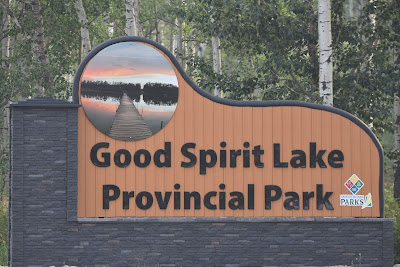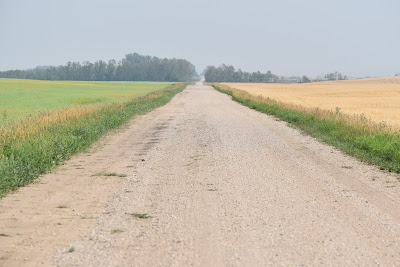Nature Beauty and Long Concessions : Good Spirit Lake to Yorkton
We
awoke this morning at 5:00 am to the inevitable sound of American Crows
complaining somewhere in the otherwise peaceful campground. The soft
morning light filtered through the aspens and spruce at the edges of our site,
and as I waited for the water to boil for morning coffee I watched a pair of
Eastern Kingbirds feeding large fledglings in a nearby tree. The only low
point of the morning was having to put on clothes that were still soaking wet
from yesterday's washing and the morning dew.
As we reluctantly headed back up to the treed parking lot we heard the loud, persistent calls of a pair of Merlins arguing in the tops of the tall spruce trees. A small group of Black-capped Chickadees was busily foraging and chatting in a nearby spruce, and two separate pairs of American Redstarts were desperately feeding fledglings the caterpillars and insects they gleaned from the edges of a small forested trail. A pair of Common Yellowthroats were also feeding young in the vicinity, adding to the excitement. In the background the toy horn calls of a White-breasted Nuthatch joined the din.
We soon found ourselves on a gravel concession, heading south towards Whitesand. The road had a deep layer of gravel over top soft sand, which made for tough going with the carts, but the scenery was beautiful. The landscape was a mix of gently rolling pastures, hay fields that were burnt a rich golden brown and dotted with large bales of spun hay, and old fields slowly filling in with saplings and shrubs. Trembling aspen stands were scattered throughout, and in places they lined the road edges.
In one pasture a small herd of curious cows came over to watch us trundle past and then gathered together to discuss the strange sight among themselves. A little farther on we spotted a group of five horses or various colours peering shyly through the trees. Tall un-mowed grasses and wildflowers lined the road in this slightly wild and less tamed landscape.
As the golden light slanted across the fields and marshes, and the breeze caused the trembling aspens to whisper, we spotted a sign indicating that a large area of land had been set aside as wildlife habitat. A plaque dedicated the lands to the memory of Allen Spelay, who worked with the Saskatchewan Wildlife Federation, the Fish and Wildlife Development Fund, and Ducks Unlimited Canada. This was a strong reminder for us of the important impact one individual can have on wildlife preservation.
A little farther down the road we were surprised to see three ornate, silver, onion domes rising up above the trees. We had arrived at the St. Mary's Ukrainian Catholic Cemetery, and the St. Mary's Parish of Whitesand's church.
Ukrainian settlers first arrived in the area in 1903, coming primarily from the village of Lytsivka in the Dolyna country. A Presbyterian Church first occupied the site in 1911, but it was dismantled in 1937 and the new structure was built. In 1941 the parish consisted of 75 members and 200 hundred children. In 1961 there were 38 families and 15 single members left, and as of 2003 only 25 members remained.
We walked up to the beautiful white panelled building, the sun peeking through the domes at the top. There was an ornate iron cross at the side, and a cemetery filled with white stone markers. We could see light streaming through the coloured glass windows, and we wished the church was open so we could explore the inside.
Shortly after passing the cemetery our App indicated that we should turn east, but the Trans Canada Trail marker indicated we should continue straight. We followed its direction, and found ourselves passing a blue wooden fence creatively and artistically covered with hub caps of all sizes and designs. It was pretty interesting, but well defended by a pair of very large dogs.
We continued through rolling countryside, much of which was gently undulating burnt brown pastures dotted with black and reddish brown cows. Among the pastures we again passed several old abandoned buildings and farms which lent texture and a hint of bygone days to the wild west landscape.
As we turned east and then south we suddenly found ourselves sharing the road with a convoy of huge double-long trucks hauling loads of sand. For about 15 minutes we were passed by a truck every 3 minutes or so. Then we'd get a break for a few minutes, and then the group of trucks would come back, spaced a few minutes apart. The drivers were amazing, slowing right down each time they passed us, pulling over as far as they could, and giving us a wave. They must have each passed us about 25 times over the span of the next 5 hours (25 km), and we hoped they didn't get in trouble for hauling fewer loads than usual due to their slower pace.
Despite the driver's very much appreciated consideration, each time one of these huge trucks passed us we were completely engulfed in a thick, choking, cloud of dust. We began to think that by the end of the day we would be invisible, covered in so much dirt and grit we'd entirely blend in with the road, except for two sets of eyeballs.
As the morning wore on and we began to bake in the hot sun, we started to get a bit frustrated with ploughing the carts through the deep sand of the road edges, and with the constant dust clouds that filled our noses, mouths, and eyes. It got so bad that Sean had to put the camera away because the dust has begun to cause the lens to malfunction.
We took a break at a lone historical plaque for the St. Ebenezer Baptist Church, which was once located at the spot and served as the religious and social centre of the community. The marble plaque was located about 20 m off the road in a mowed area of grass surrounded by open, hot, sunny, field. It felt good to take a break from the trucks, but the clouds of dust blew so far off the road they still managed to reach us.
As we rested a bit we watched a small yellow crop dusting plane doing very impressive loops and turns as it sprayed the crops along the road ahead. It would fly way up and then zoom towards the earth so low it disappeared below the tree line, before pulling sharply up, looping tightly around, and swooping in for the next pass. For the next 10 km or so the plane would be our companion, at one point coming so close we could feel the spray from the chemicals it was releasing onto the adjacent field. The pilot must have wondered what we were up to.
After this we scuttled across the busy Yellowhead Highway, and found ourselves at the edge of town. We passed the offices of Ducks Unlimited Canada, tucked away at the edge of a large marsh which we hope to explore tomorrow, and the Museum of Industry, which we also hope to visit again. A definite highlight was stopping for scoops of ice cream at the corner store. As we continued down the road, walking parallel to the train tracks, two trains pulled through, sounding their whistles at all the intersections. The driver of the second train gave us a whistle and a wave as he passed, which was a really great welcome to the town.
Yorkton is a city of around 20,000 people, and it offers all the modern amenities, as well as many chain stores and hotels. It is easily the biggest community we've visited along the Trans Canada Trail since leaving Winnipeg, and it feels like a pleasant culture shock. We plan to spend a day here catching up, cleaning up, and exploring all it has to offer.
See you on the trail!
Remember to follow our entire adventure here : www.comewalkwithus.online










































Comments
Post a Comment